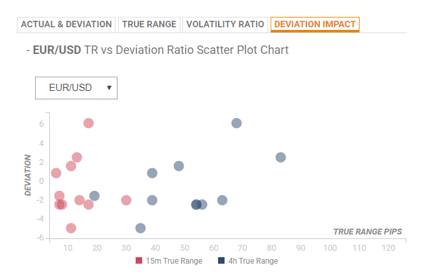When are the Eurozone Preliminary CPIs/ GDP and how could they affect EUR/USD?
by Dhwani MehtaEurozone Preliminary CPIs and GDP overview
Eurostat will publish the first estimate of Eurozone inflation and growth figures for January and Q4 respectively at 1000 GMT today.
The headline CPI is anticipated to come in slightly firmer at 1.4% YoY while the core inflation is also seen down to 1.2% YoY during the reported month.
On an annualized basis, the bloc’s economic growth is seen at 1.1% in Q4 while inter-quarter the GDP rate is expected to come in at 0.2% vs. 0.2% previous.
Deviation impact on EUR/USD
Readers can find FX Street's proprietary deviation impact map of the event below. As observed the reaction is likely to remain confined between 10 and 30 pips in deviations up to 1.5 to -2, although in some cases, if notable enough, a deviation can fuel movements of up to 45-50 pips.

How could affect EUR/USD?
Haresh Menghani, FXStreet's own Analyst, offers important technical levels ahead of the key release: “Traders are likely to wait for a sustained breakthrough November monthly swing lows support, near the 1.0980 region, before positioning for any further near-term depreciating move. Below the mentioned support, the pair is likely to accelerate the slide and aim towards challenging the 1.0900 round figure mark.”
“On the flip side, any subsequent recovery is likely to confront stiff resistance near the 1.1060-70 confluence region – comprising of 50% Fibonacci level of the 1.0879-1.1239 positive move and 100-day SMA. This is closely followed by a 3-1/2-month-old ascending trend-line support breakpoint, now turned resistance near the 1.1085 region, and 38.2% Fibo. level around the 1.1100 mark,” Haresh adds.
Key notes
German Retail Sales plunge 3.3% MoM in Dec, a big miss – EUR/USD keeps lows
EZ inflation and GDP preview: Downbeat figures could trigger the next leg down for EUR/USD
EUR Futures: Rebounds look shallow
About Eurozone Preliminary CPIs and GDP estimate
The Euro Zone CPI released by the Eurostat captures the changes in the price of goods and services. The CPI is a significant way to measure changes in purchasing trends and inflation in the Euro Zone. Generally, a high reading anticipates a hawkish attitude which will be positive (or bullish) for the EUR, while a low reading is seen as negative (or bearish).
The Gross Domestic Product released by the Eurostat is a measure of the total value of all goods and services produced by the Eurozone. The GDP is considered as a broad measure of the Eurozone economic activity and health. Usually, a rising trend has a positive effect on the EUR, while a falling trend is seen as negative (or bearish ).